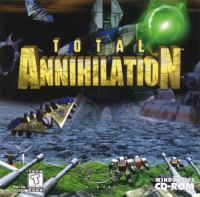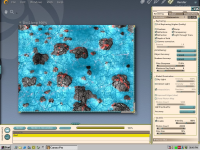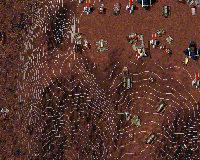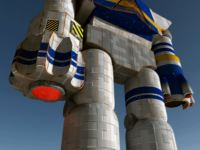What is this Total Annihilation RTS game all about?¶


What began as a conflict over the transfer of consciousness from flesh to machines escalated into a war which has decimated a million worlds. The Core and the Arm have all but exhausted the resources of a galaxy in their struggle for domination. Both sides now crippled beyond repair. The remnants of their armies continue to battle on ravaged planets. Their hatred fueled by over four thousand years of total war. This is a fight to the death. For each side, the only acceptable outcome is the complete and total annihilation of the other…
Total Annihilation, Cavedog Entertainment’s groundbreaking 3-D real-time strategy game, was simultaneously launched in three languages and 14 countries on 09/27/1997, blasting more than 250,000 games into retail stores during its first month of release.
It is recognized as one of the best PC and Mac games of all time (as well as the best RTS of all time, according to GameSpy). It defined the third-generation class of real-time strategy games when it was released. “Real-time” means that both the human and computer players do not take turns in sequence, but simultaneously. In effect, each player takes a turn whenever they want, without waiting for a turn. Total Annihilation is often compared to another very popular RTS game from Blizzard called Starcraft, of second-generation design. Though Starcraft has three races and an involving storyline, Total Annihilation uses a realistic physical simulator in which battles are fought. But how good is its gameplay?
Well, part of what makes Total Annihilation amazing as well as challenging to play is in how its game engine handles terrain. For starters, the terrain is 3D. This means that hills and mountains have a real height to them. The game maps are not just pretty painted 2D battlefields. These areas can actually halt combat units from moving further that don’t have climbing abilities, so they’ll have to travel around or shoot over them to attack their enemy. Bryce was one of the first 3D terrain programs used in the ’90s for creating many of the game’s maps. Newer programs like Carrara have been added to the growing list of programs being used now. However, Vue is able to generate the best detailed maps for the game.

A TA map made in Carrara.
The units in the game are rendered (in real-time) in 3D, using DirectX 5. Vehicles tilt up and down, left and right, when travelling on a slope. And they can be blocked by debris or by each other along narrow passageways where ambushes await them. Some of their weapon turrets can rotate 360 degrees to get a better aim on enemy targets. Weapons with line-of-sight to their targets can fire lasers directly at them. Other weapons that can’t see over fortress walls or hills can fire their shells in an arc to hit their targets using a physics system (once a target is detected either by radar or by spy planes flying overhead). Strong wind or gravity will cause units to travel slower and can impair their weapon’s accuracy.
Oceans are also treated as 3D. With the Core Contingency expansion pack installed, Submarines can be used to build secret underwater bases on the ocean floor, as long as the enemy isn’t using sonar to discover it and sends in Attack Subs, Depth Charges, and Torpedo Bombers to ruin things.

Note the contour lines that define the 3D terrain.
The terrain is also alterable, meaning trees and rocks can be blown up so that units can traverse forests and rocky canyons. Forest fires can cause damage to units and buildings that are nearby. High winds can help spread forest fires that get started.
Another nice thing about the game is its graphical user interface. It is very intuitive as well as informative. Commands are given to units either by mouse or by keyboard. The interface allows players to plan and strategize more instead of micromanaging everything. Factories can build units unattended by queuing up the number of each unit to be built. Factories can order the units how they’ll behave against enemies and where to relocate to after they’re built. The game map’s overhead camera angle is fixed, pointing down at a 63.44 degree angle. This allows players to get a good view of a battle and give orders to their units. All units on the map (not just on the screen) can easily be selected and given orders. Holding down the SHIFT key allows players to queue up move/patrol/attack/capture/guard/repair/recycle orders given to units. There is no limit to queuing orders. However, there is a limit to the number of units players can have for their army which is 500.
Playing against human players in Total Annihilation is one of the best features in the game.

TA has several ways of playing networked games.
One player is chosen to host a network multiplayer game and allows others to connect to his computer. While waiting for players to join, the host player can choose which world map will be played on and which units will be allowed in battle. Players can decide what teams (if any) they will play on. And the starting amount of metal and energy per player is also assigned.
Worlds that are fought on contain metal deposits and energy. Some planets (artificial ones built by the Core) are made of solid metal. The metal is collected by building Metal Extractors which drill into the ground. The metal deposits do not run out. Bigger Extractors will collect more amounts of metal. Extra metal needs to be kept in Metal Storage units. The more metal one has, the more one can build. Metal Extractors can easily be destroyed or taken over by enemies. Units that are destroyed can often leave chunks of metal behind that can be recycled by either army close enough to it. Rocks provide a limit source of metal that can by recycled.
Energy is the other important resource found on worlds that is necessary for building and powering units. It comes in different forms. Solar energy is one such form that can be collected and stored. Water current and wind can be used to generate energy. Recycling plant life provides a limited means of energy gathering. The best way to produce energy though is by building Fusion Reactor Plants. And if one has extra amounts of energy stored up, they can even convert it into metal! Energy is required to power the Metal Extractors, factories, and unit weaponry.
In general, he who controls the metal – controls the world. When a player builds Metal Extractors over metal deposits and defends them, he expands his base across a world map in the process. The more real estate a player has, the more control over a world they have. And the less room there is for others to exist on. And a player with more metal and energy, the more they can build and attack others with and more often. You get the idea.
A typical game of Total Annihilation can last 10 - 15 minutes on a small-sized world map, 25 - 40 minutes on a medium-sized world map, and 50 - 120 minutes on a large-sized world map. There are epic-sized world maps that can make battles go on for over a day or two.
Most of the time though, the first 10 minutes is spent building a base from nothing. The next 5 minutes is spent building simple defensive and attack units. This is where players begin seeing some battles going on, to let each other know that the other exists. The next 15 - 20 minutes is spent upgrading defenses and attack units. All the while, bases on each side are expanding and collecting more and more resources. On a medium-sized world map, enemy bases begin to border each other and fights can’t help but break out. From 20 - 40 minutes, advanced land, air, and sea units are entering major battles while long range weaponry begins being built, such as nukes. The remainder of the game (on large-sized world maps) is spent unleashing nearly every advanced unit and nuke on the other guy until the game is won (or lost, as the case may be).
If a game is set to kill a player’s Commander unit in order to win a game, the game is pretty much over by now. But on epic-sized world maps, where the game is set to continue on even after a player’s Commander is killed, a game might never end. This is because players can keep on repairing their bases and armies after each attack. Draws can often be had on such world maps where there are only two players remaining, and neither can take the other one out (even with nukes). But on medium to large maps, there just isn’t enough room to have two huge bases and their armies. So one has to go.
Some nice things about units is that they do not travel through other units, buildings, and debris. Units can get jammed behind other jammed units in front of them. This makes it easy for the enemy to blast away at chunks of clogged units and get more kills for the buck. Units can be destroyed simply by being hit by debris from nearby units (friend or enemy) being destoyed. Chain reactions can happen when units are too close together, like Fusion Reactor Plants. Surviving units can be repaired though and even earn veteran status if they last long enough in battle. Some units can carry other units. And some units even have stealth while some can jam radar and sonar units. The units that work as radar can show more of a world map that is hidden from other unit’s line-of-sight. Players can share their line-of-sight and radar info with other team players. And all units can self-destruct!
Units can be controlled by human players or by computer players. Each world map determines what computer AI gets used when a computer player is added into a game. Each human player is allowed to add one computer player into a game. Each computer player can be sided with or against other human and computer players. And one human player can actually play against nine computer players on a world map if he wants. This is called skirmishing, which allows one to practice their game alone or when there are no other human players. The computer player’s AI can easily be customized.
One could ask the question, “But isn’t all this in all RTS games?”
Well… Yes and no.
Yes, other RTS games are now using 3D terrain. But still no in two other factors.
No, mobile units are not making full use of the 3D terrain. Their terrain maps may be painted to look 3D, but they are actually flat. And units are forbidden from travelling across certain areas of the map to maintain the illusion of it being 3D. Units also can’t travel or fire in all 360 degrees of direction. They just move and shoot in only eight directions. Their weapons never miss their targets, which seems rather unrealistic in a game where there are obstructions, either natural or manufactured, that are obviously able to block laser fire. And their worst cardinal sin of all is that their units travel right through each other and other structures.
And no, they don’t use their oceans fully. Often times, the player doesn’t have much control over naval units in a game. They just show up when needed. In Total Annihilation, you need to be able to build your base anywhere on a map. And sometimes it’s all water, as in a water world. There are ways of making metal on such worlds to build navies with, so that’s not a problem. If one were to find themself on a dirt world only with no metal, they could make metal of their own to build an army from.
And also no on immense battles. We’re talking huge, giant battlefields up to 63 x 63 screens in size here. A Total Annihilation game could have ten players with up to 500 units each on one of these maps. Some players are against each other while some are allied. Some are choosing to build navy units. Others are choosing ground units. Still others are going with air units. It could be a map with unlimited metal, limited metal, or no metal at all. Just the thought of all this makes any serious RTS gamer want to fire up Total Annihilation.
“And what about the game’s story? Or the fact that it doesn’t have three distinct races like Starcraft does?”
True and true. There isn’t much of a story other than two armies fighting each other for control over an entire galaxy. Basically, there are two armies in Total Annihilation, the Core and the Arm. Years from now, humans that have been used to cloning for centuries, are faced with the idea of upgrading their fleshy bodies to robotic machines with far more memory than their cloned brains can hold. Some clones will fight against this and rebel. They’ll spread themselves out along the spiral arm of the galaxy so they can better plan how to wage war against a metallic empire centered at the galactic core.

The Arm Commander unit.
So the game has clones and machines fighting each other using high-tech vehicles and weaponry. Clones can replace replicated dead clones and machines can replace recycled destroyed machines. And this can go on and on for millennia according to the game’s manual. By the way, both armies each have over 110 different types of units they can build.
“It’s as though the game developers were intensionally focusing more on the strategic play of Total Annihilation rather than on the game’s intricate plot or the diversities of the races involved.”
True again. Because what all can one really do when one is given just nine months to create an RTS that is going to be the very best one for a very long time (now going on seventeen years)?
If you understand how World War II was conducted – the strategies that were used, the immense number of units and weapons that had to be built, attacked with, repaired, refueled, and protected, the various terrains that had to be traversed, defended, invaded, captured, or destroyed – then you have a real sense of the strategic level and scale of battle that Total Annihilation delivers time and time again.
Through the years and even to this day, unfortunately, some of Total Annihilation’s players, known as modders, have made modifications to the game’s units and weapons and even created totally new ones. And because these “modders” weren’t game designers in any kind of way, the modifications they made did more harm than good to Total Annihilation’s original play balance and spirit of the game.
A sort of chain-reaction to all of this was a splintering of Total Annihilation’s gaming audience into small groups that then took paths of their own away from newer players of the game. Further modifications were made based on, or on top of, existing modifications until there became this vast sea of mediocrity which tainted the game. Players eventually found it hard to start up an online game without first having to download and patch their installs simply so they could be compatible with each other.
The same can be said about trying to watch a recorded game hosted on TADRS at tadrs.tauniverse.com. Or should it be called Tatters, since it can’t even keep track of what maps or units were used in each game in order to watch them?
Smart players and true fans of the game have realized all along that the game should be left alone and played just as Cavedog’s game designers intended.
Anyway. Happy 27th Anniversary, Total Annihilation!
